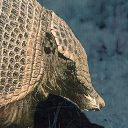Assembly
This is the new release of the draft assembly of the armadillo (Dasypus novemcinctus) genome, Dasnov3.0, provided by the Baylor College of Medicine in Dec 2011. There are 46,558 scaffolds comprised of 314,971 contigs with a scaffold N50 of 1,717,291b and a contig N50 of 26,277b. The N50 size is the length such that 50% of the assembled genome lies in blocks of the N50 size or longer.
Aim
The aim is to increase our understanding of functional elements, especially in the human genome. Dasypus novemcinctus is of particular interest to developmental biologists owing to its habit of producing litters of four genetically-identical young, and it is also the animal model for leprosy.
Other assemblies
- ARMA (Ensembl release 54)
Gene annotation
Dasnov3.0 was annotated using the standard Ensembl gene annotation system, incorporating RNAseq data provided by BROAD Institute. Gene models are based on:
- Models build from armadillo RNASeq data using our in-house RNASeq pipeline
- Genewise alignments of UniProt protein sequences from mammal species
- Exonerate alignments of Ensembl human proteins from Ensembl release 71
Protein-coding models were extended into their untranslated regions using RNASeq models. In addition to the coding transcript models, non-coding RNAs and pseudogenes were annotated.
RNASeq data set
In addition to the Ensembl gene set, we produced RNAseq-based gene models and an indexed BAM file for each sample used by the RNAseq pipeline and also for the merged data from all tissues. Each RNAseq-based gene model represents only the best supported transcript model. We did a BLASTp of these transcript models against UniProt proteins in order to annotate the open reading frame. The best BLAST hit is displayed as a transcript supporting evidence.
The tissue-specific sets of transcript models built using our RNAseq pipeline are as follows:
| Tissue | Number of gene models | |
|---|---|---|
| Set 1 | Set 2 | |
| Ascending Colon | 17046 | 16937 |
| Cerebellum with brainstem | 17289 | 17405 |
| Heart | 14723 | 14786 |
| Kidney | 16047 | 16041 |
| Liver | 15643 | 15856 |
| Lung | 17891 | 18020 |
| rt Quadricep | 14450 | 14569 |
| Spleen | 16988 | 17093 |
| Merged | 21177 | |
The RNAseq data were used to add UTR to protein coding models. Additional splice junctions (introns) may have been identified by our pipeline and not included in the best supported transcript model. We therefore provide users with the full set of introns identified by our RNAseq pipeline to enable further analysis. These introns were identified by searching for reads that splice when mapped to the genome.
More information
General information about this species can be found in Wikipedia.
Statistics
Summary
| Assembly | Dasnov3.0, INSDC Assembly GCA_000208655.2, Dec 2011 |
| Base Pairs | 3,631,522,711 |
| Golden Path Length | 3,631,522,711 |
| Annotation provider | Ensembl |
| Annotation method | Mixed strategy build |
| Genebuild started | Jun 2013 |
| Genebuild released | Dec 2013 |
| Genebuild last updated/patched | May 2016 |
| Database version | 115.3 |
Gene counts
| Coding genes | 22,711 |
| Non coding genes | 9,163 |
| Small non coding genes | 5,510 |
| Long non coding genes | 3,179 |
| Misc non coding genes | 474 |
| Pseudogenes | 1,500 |
| Gene transcripts | 37,723 |
Other
| Genscan gene predictions | 64,600 |
